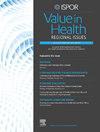Budget Impact Analysis of Intravitreal Injections Used to Treat Neovascular Age-Related Macular Degeneration and Diabetic Macular Edema in the Dubai Healthcare System
IF 1.4
Q3 HEALTH CARE SCIENCES & SERVICES
引用次数: 0
Abstract
Objectives
With the rising prevalence of neovascular age-related macular degeneration (nAMD) and diabetic macular edema (DME), this study assesses the budget impact of current intravitreal injections (faricimab, brolucizumab, ranibizumab, and aflibercept) on Dubai’s private sector. The aim is to identify the most cost-effective intervention by evaluating utilization costs based on injection frequencies and direct acquisition expenses.
Methods
An Excel-based budget impact model, aligned with the current standard of care, incorporates direct medical costs only, acquisition prices of the 4 interventions, procedure costs, optical coherence tomography diagnosis and consultation visit costs, and average administration costs in Dubai’s healthcare system. Local experts’ opinions shape the clinical approach and costs. The model spans a 5-year horizon, considering a complete replacement or gradual increase in faricimab uptake. One-way sensitivity analysis ensures outcome robustness.
Results
The model, based on an estimated prevalence of 722 nAMD patients and 14 885 DME patients, projects faricimab’s growing market share yielding estimated total savings of 402 908 275 Arab Emirates Dirham over 5 years compared with current market shares. The savings stem from faricimab’s lower injection frequency and acquisition cost in managing DME and nAMD in Dubai’s healthcare system.
Conclusions
Increasing faricimab uptake promises substantial budget savings. Decision makers in Ophthalmology Care in the United Arab Emirates can efficiently allocate resources by endorsing faricimab as the primary treatment for nAMD and DME based on these findings.
迪拜医疗系统玻璃体内注射用于治疗新生血管性年龄相关性黄斑变性和糖尿病性黄斑水肿的预算影响分析
随着新血管性年龄相关性黄斑变性(nAMD)和糖尿病性黄斑水肿(DME)患病率的上升,本研究评估了目前玻璃体内注射(faricimab、brolucizumab、ranibizumab和aflibercept)对迪拜私营部门的预算影响。目的是通过评估基于注入频率和直接获取费用的利用成本来确定最具成本效益的干预措施。方法基于excel的预算影响模型,与当前护理标准保持一致,仅纳入迪拜医疗系统的直接医疗成本、4种干预措施的购置价格、手术成本、光学相干断层扫描诊断和咨询访问成本以及平均管理成本。当地专家的意见决定了临床方法和成本。该模型跨度为5年,考虑完全替代或逐渐增加法利昔单抗的摄取。单向敏感性分析确保了结果的稳健性。结果该模型基于722名nAMD患者和14 885名DME患者的估计患病率,预测faricimab不断增长的市场份额与目前的市场份额相比,在5年内估计总节省402 908 275阿拉伯酋长国迪拉姆。节约源于faricimab较低的注射频率和采购成本在管理DME和nAMD在迪拜的医疗保健系统。结论增加法昔单抗的使用有望节省大量预算。基于这些发现,阿拉伯联合酋长国眼科护理的决策者可以通过支持faricimab作为nAMD和DME的主要治疗方法来有效地分配资源。
本文章由计算机程序翻译,如有差异,请以英文原文为准。
求助全文
约1分钟内获得全文
求助全文
来源期刊

Value in health regional issues
Pharmacology, Toxicology and Pharmaceutics-Pharmacology, Toxicology and Pharmaceutics (miscellaneous)
CiteScore
2.60
自引率
5.00%
发文量
127
 求助内容:
求助内容: 应助结果提醒方式:
应助结果提醒方式:


